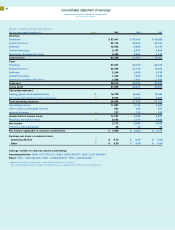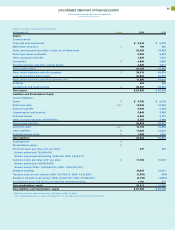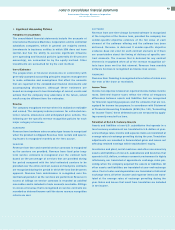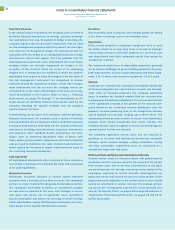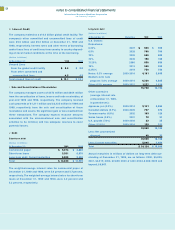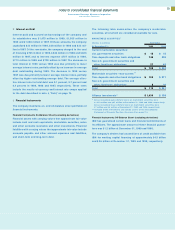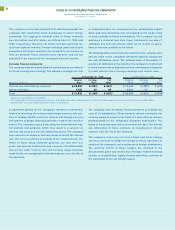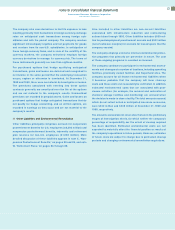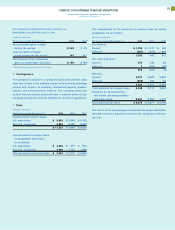IBM 1999 Annual Report Download - page 72
Download and view the complete annual report
Please find page 72 of the 1999 IBM annual report below. You can navigate through the pages in the report by either clicking on the pages listed below, or by using the keyword search tool below to find specific information within the annual report.
notes to consolidated financial statements
International Business Machines Corporation
and Subsidiary Companies
Financial Instruments
In the normal course of business, the company uses a variety of
derivative financial instruments to manage currency exchange
rate and interest rate risk. To qualify for hedge accounting, the
company requires that the derivative instruments that are used
for risk management purposes effectively reduce the risk expo-
sure that they are designed to hedge. For instruments that are
associated with the hedge of an anticipated transaction, hedge
effectiveness criteria also require that it be probable that the
underlying transaction will occur. Instruments that meet these
hedging criteria are formally designated as hedges at the
inception of the contract. When the terms of an underlying
hedged item or transaction are modified, or when the underly-
ing hedged item ceases to exist, all changes in the fair value of
the risk management instrument are recognized in income
each period until the instrument matures. Those risk manage-
ment instruments that do not meet the hedging criteria are
accounted for at fair value, and changes in fair value are recog-
nized immediately in net income. Refer to note L, “Financial
Instruments,” on pages 75 through 77 for descriptions of the
major classes of derivative financial instruments used by the
company, including the specific methods that the company
uses to account for them.
In determining the fair value of its derivative and non-derivative
financial instruments, the company uses a variety of methods
and assumptions that are based on market conditions and risks
existing at each balance sheet date. For the majority of financial
instruments including most derivatives, long-term investments
and long-term debt, standard market conventions and tech-
niques such as estimated discounted value of future cash
flows, option pricing models, replacement cost and termination
cost are used to determine fair value. Quoted market prices or
dealer quotes for the same or similar instruments are used for
the remaining financial instruments.
Cash Equivalents
All highly-liquid investments with a maturity of three months or
less at date of purchase are carried at fair value and considered
to be cash equivalents.
Marketable Securities
Marketable securities included in current assets represent
securities with a maturity of less than one year. The company’s
policy is to invest in primarily high-grade marketable securities.
The company’s marketable securities are considered available
for sale and are reported at fair value with changes in unreal-
ized gains and losses, net of applicable taxes, recorded in
Accumulated gains and losses not affecting retained earnings
within stockholders’ equity. Realized gains and losses are calcu-
lated based on the specific identification method.
Inventories
Raw materials, work in process and finished goods are stated
at the lower of average cost or net realizable value.
Depreciation
Plant, rental machines (computer equipment that is used
internally, subject to an operating lease or as part of strategic
outsourcing contracts) and other property are carried at cost
and depreciated over their estimated useful lives using the
straight-line method.
The estimated useful lives of depreciable properties generally
are as follows: buildings, 50 years; building equipment, 20 years;
land improvements, 20 years; plant, laboratory and office equip-
ment, 2 to 15 years; and computer equipment, 1.5 to 5 years.
Software
Costs that are related to the conceptual formulation and design
of licensed programs are expensed as research and develop-
ment. Also, for licensed programs, the company capitalizes
costs to produce the finished product that are incurred after
technological feasibility is established. The annual amortization
of the capitalized amounts is the greater of the amount com-
puted based on the estimated revenue distribution over the
products’ revenue-producing lives, or the straight-line method,
and is applied over periods ranging up to three years. The
company performs periodic reviews to ensure that unamortized
program costs remain recoverable from future revenue. The
company charges costs to support or service licensed programs
against income as they are incurred.
The company capitalizes certain costs that are incurred to
purchase or to create and implement internal use computer
software, which include software coding, installation, testing
and data conversion. Capitalized costs are amortized on a
straight-line basis over two years.
Retirement Plans and Nonpension Postretirement Benefits
Current service costs of retirement plans and postretirement
healthcare and life insurance benefits are accrued in the period.
Prior service costs that result from amendments to the plans
are amortized over the average remaining service period of the
employees expected to receive benefits. Unrecognized net
gains and losses that exceed ten percent of the greater of the
projected benefit obligation or the market-related value of plan
assets are amortized to service cost over the average remain-
ing service life of employees expected to receive benefits. See
note W, “Retirement Plans,” on pages 86 through 88 and note X,
“Nonpension Postretirement Benefits,” on pages 88 and 89 for
further discussion.
70






